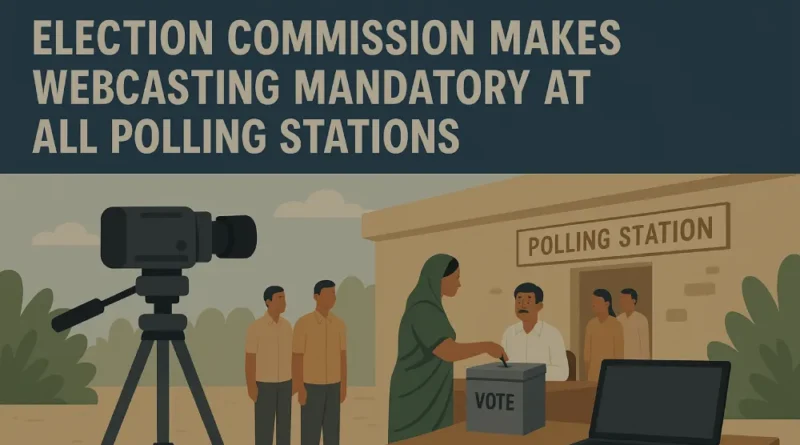Election Commission Makes Webcasting Mandatory at All Polling Stations
What is poll‑day webcasting?
Poll-day webcasting is the live streaming of video and sound from events at voting places during elections. Officials from the Election Commission (EC) and other government units, like district and state control rooms, can watch the voting process in real time thanks to this technology. The goal is to keep the political process honest, make sure that things are open and honest, and cut down on wrongdoing.
From Partial to 100% Coverage
In earlier stages, the EC said that either all “critical polling stations” or at least half of all polling stations in a district had to webcast the election. These important places were usually picked out because of wrongdoing or safety issues in the past.
But in 2025, the EC changed the rules: all voting places that can connect to the internet must now have the technology to show the results. Where there is no internet access (called “shadow zones”), the EC requires other ways like photography or filming that can be done offline.
This change will be fully put into place for the upcoming Bihar Assembly elections. Bihar will be the first state to have webcasting in all of its voting places.
Why Webcasting Matters
1. Transparency and Trust
Webcasting allows officials to oversee the entire polling process remotely. From the mock poll conducted before voting begins, to the sealing of electronic voting machines (EVMs) after voting ends, everything is visible to the authorities. This transparency builds trust in the electoral process.
2. Deterrence Against Malpractice
Live video streaming acts as a deterrent to election-related crimes like voter intimidation, booth capturing, or undue influence on polling staff. The fear of being caught on camera makes it harder for bad actors to disrupt the process.
3. Real-Time Monitoring and Swift Action
With multi-level control rooms set up at the state, district, and constituency levels, any irregularity caught on camera can be flagged immediately. Officials can then coordinate a swift response—whether by deploying security, replacing errant staff, or correcting procedural issues.
4. Internal Review and Accountability
The Election Commission has clarified that the footage is meant for internal monitoring only and is not available to the public. This ensures the footage is used constructively for governance without compromising privacy or creating unnecessary controversies.
How It Works
Setup and Infrastructure
Polling places that can connect to the internet must put in cams for live streaming. High-resolution video recording is needed in places that don’t have internet access. At least two days before election day, all voting places must test their systems to make sure they work.

Control Rooms
Monitoring centers are established at three levels:
- State
- District
- Assembly Constituency
Each center is staffed with officials who monitor the video feeds in real-time. Nodal officers are designated to oversee operations and report incidents.
Day of Polling
Live feeds are watched nonstop all day, from the practice runs before the election to the end of the voting. If officials in the control rooms think there are problems, they quickly tell the ruling officer or district election officer so that they can step in and fix the problem right away.
Privacy Measures
To protect the secrecy of the ballot, cameras are not pointed toward the voting machines or VVPAT slips. The EC ensures that the webcasting setup does not infringe upon voter privacy.
Case Study: Ludhiana West By-election
During the Ludhiana West by-election, webcasting was part of a larger monitoring strategy that also included micro-observers and model polling stations. It demonstrated how technology and human oversight can work in tandem to ensure smooth and credible elections.
Challenges
Infrastructure Gaps
Some remote or rural areas still lack basic internet connectivity, requiring the EC to fall back on offline video recording. Expanding infrastructure remains a key challenge.
High Costs
Deploying high-quality cameras, ensuring data security, and hiring technical staff for monitoring can be expensive, especially in large-scale elections.
Data Storage and Privacy
Managing vast amounts of video footage securely without leaks or misuse poses another major concern. The EC must ensure that data is used only for authorized purposes.
Conclusion
The Election Commission’s choice to require 100% webcasting at voting places is a big step forward in making Indian elections more open and efficient. Webcasting improves democracy and builds public trust by letting people watch in real time and make changes quickly. With the polls coming up in Bihar, this full-scale launch could be used as a model for votes all over the country in the future.
Disclaimer
The information presented in this blog is derived from publicly available sources for general use, including any cited references. While we strive to mention credible sources whenever possible, Web Techneeq – Best Website Development Agency in Mumbai does not guarantee the accuracy of the information provided in any way. This article is intended solely for general informational purposes. It should be understood that it does not constitute legal advice and does not aim to serve as such. If any individual(s) make decisions based on the information in this article without verifying the facts, we explicitly reject any liability that may arise as a result. We recommend that readers seek separate guidance regarding any specific information provided here.

